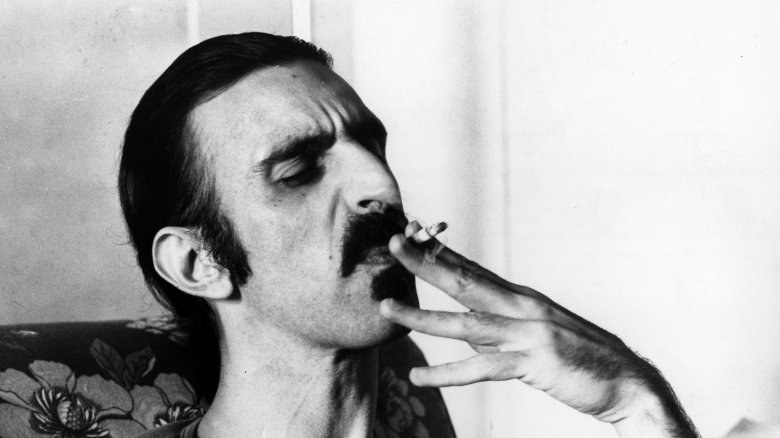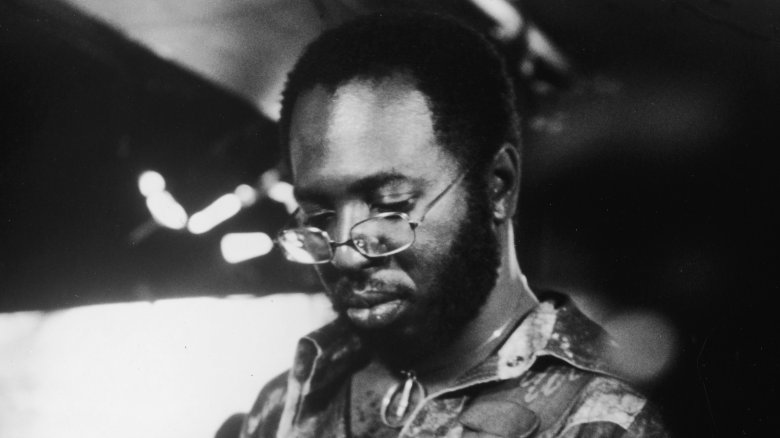Musicians Who Permanently Damaged Their Bodies Performing Live
They say that rock 'n' roll will never die, but playing it on stage could very well kill you — or at least leave you with debilitating injuries, permanent scars, or lots of aches and pains that will nag you for the rest of your life. The same goes for other genres as well, from pop to soul to cabaret. Just ask these legendary rockers, pop stars, and other performers. The music biz is dangerous.
It doesn't always have to be. Sometimes performers practically court danger with onstage antics like leaping off stage risers, packing a drum kit with explosives, or attempting to grab an in-flight aerial drone made partly of sharp, spinning blades. But in other situations, musicians have every reason to expect that props, pyrotechnics, complex equipment, and even the weather will behave as expected — only to learn that, in music as in life, you can't take anything for granted.
Prince's bad hips
Prince was well known for his amazing live shows but, in his younger years, he really cut loose. He often wore high-heeled shoes while performing in the early '80s and, despite his choice of impractical footwear, he often jumped off stage risers. His protege Sheila E. joined him during his 1984-85 Purple Rain tour as an opening act and, according to The Guardian, she later told the press that, even back then, Prince "was in pain all the time."
In the years that followed, he was sometimes spotted limping or even riding a motorized scooter to get around while out on tour. The chronic pain that tormented him became so bad that he allegedly turned down a double hip replacement operation due to his religious beliefs. (Jehovah's Witnesses aren't allowed to get blood transfusions.) However, this didn't stop him from often relying on painkillers to manage his nagging injuries.
He was reportedly using opioids during his later years, and his addiction got so bad that he turned to a California-based specialist named Dr. Howard Kornfeld to beat his habit mere days before his death. Kornfield was unable to personally consult with Prince at his Paisley Park home and studio complex near Minneapolis so he sent his son, Andrew, to plan a treatment program. Andrew was among those who discovered Prince's body in an elevator on April 21, 2016.
Tommy can't hear you, and neither can Pete Townshend
The Who's lead guitarist suffers from hearing loss. One of the contributing factors beyond spending many years standing in front of loud amps? Former drummer Keith Moon's tendency to blow up his drum kit during their infamous live shows.
The band was riding high in the autumn of 1967 when "I Can See for Miles" became their first Top 10 hit in America. They booked a gig on "The Smothers Brothers Comedy Hour." Unlike the stodgier ones over at "The Ed Sullivan Show," the brothers' producers actually encouraged The Who's destructive tendencies, which typically included smashing guitars. As Townshend later explained during a VH1 special about what followed, Moon convinced a technician to build him a small "cannon" for his drum kit. During the rehearsal, it created an explosion that wasn't very impressive. Moon insisted on amping up its firepower so the band's performance could end with a proper bang.
The stage manager obliged, but he didn't know that the drummer later added even more kick to the explosive device himself, ultimately giving it about three times more firepower. After the band performed "My Generation," Townshend and bassist John Entwistle diligently started breaking their instruments. That's when Moon's cannon did its thing. It also set Townsend's hair on fire and significantly damaged his hearing. However, he has claimed that listening to music on headphones over the years also greatly contributed to his noise-induced hearing loss.
Patti Smith's big pain in the neck
Many performers have fallen off stages over the years. The Foo Fighters' Dave Grohl took a tumble and broke his leg during a 2015 show in Sweden (but somehow managed to return to the stage and finish the set despite it). James Hetfield from Metallica also slipped into a trap door during a show in Amsterdam in 2017, but managed to avoid hurting anything but his ego, as he later told the press.
But falling off stages isn't reserved for men in the music industry. Patti Smith teamed up with Bob Seger and the Silver Bullet Band for a show in Tampa in 1977. Smith was known for her wild performances back then, which often included lots of twirling, but the stage crew didn't leave her with much space to work with. Even worse, it was dimly lit. She made do what with what little room she had, but her foot hit a stage monitor during the show.
That sent her tumbling over the side. Smith fell 15 feet into the orchestra pit, broke a vertebrae in her neck, and fractured her spine. She still suffers from neck pain but, as she told Uncut magazine in 2012 (via Ultimate Classic Rock), "It's nothing I can't live with."
Frank Zappa and the wheelchair
Frank Zappa, one of rock's greatest and most prolific eccentrics, suffered from chronic back pain after a bizarre incident during a performance at London's Rainbow Theater on December 10, 1971. As he and his band began a jokey cover of the Beatles "I Wanna Hold Your Hand," a man in the crowd named Trevor Charles Howell turned violent. The 24-year-old construction worker jumped on stage after flying into a rage, then shoved Zappa into the theater's orchestra pit.
While the band and much of the audience was convinced Zappa was dead, Howell attempted to flee but was apprehended by members of the crowd. As he later explained, he wasn't angry that Zappa was mocking one of Britain's most beloved rock groups but rather that his girlfriend had admitted she had a crush on Zappa.
The incident landed Zappa in a wheelchair for almost a year, according to Ultimate Classic Rock, and was the last in a series of issues that made that year's tour a real pain for both him and his band. Before the London show, a fan fired a flare gun during their gig at the Montreux Casino in Geneva, Switzerland. It caused the heating system to explode and start a fire that destroyed the band's equipment, injured several people in the crowd, and burned down the casino. But it did inspire "Smoke on the Water," Deep Purple's totally rockin' recollection of the nasty incident.
Adele's delicate vocal chords
A record-breaking 123 shows on a world tour could put a terrible strain on any singer's voice, as one of the greatest living vocalists learned in 2017. After the second of four shows in front of audiences of nearly 100,000 fans at London's Wembley Stadium, which were supposed to serve as a triumphant finale for the tour, she realized something wasn't quite right.
Adele struggled during the first two nights and kept having to clear her throat. She knew something was wrong when she contacted her doctor, who told her she'd badly damaged her vocal cords and should cancel the last two shows at Wembley. Sadly, she'd experienced a similar problem when she suffered a hemorrhage after a live performance on a French radio show in 2011 and underwent a very risky procedure called vocal cord microsurgery.
Even before the shows at Wembley, she was already considering permanently retiring from the road, The Guardian reported. But during a Las Vegas residency that began in November 2022 and is scheduled to end in June 2024, Adele assured fans that she was planned to take her show on the road once more.
Curtis Mayfield's tragic final years
The skies had grown dark over a stage set up at Wingate Field in Brooklyn on August 13, 1990. Senator Martin Markowitz hosted concerts for his constituents every summer, but things were looking grim as the legendary singer-songwriter Curtis Mayfield went on stage early to beat the storm and not disappoint the thousands of fans who had turned out. Markowitz, Mayfield, and his band were hoping they'd get through at least one song before the weather turned ugly, his son later wrote.
It was a huge mistake. As described in the 2016 book "Traveling Soul: The Life of Curtis Mayfield," (per Rolling Stone), a blast of wind blew through the crowd and over the stage as the band began playing Mayfield's hit song "Superfly." The first few rows of spectators were thrown from their seats by an abrupt, hurricane-level gust that also caused a lighting rig over the stage to come loose. It landed on Mayfield, paralyzing him from the neck down for the rest of his life.
Unfortunately, it gets worse. Mayfield also suffered from "phantom hands," an awful condition that he compared to feeling like his hands had been forced into buckets full of snakes. It didn't stop him from continuing to write and record music, though. While Mayfield could no longer play guitar, he would sing while lying on his back in the studio. He passed away on December 26, 1999, from complications of Type 2 diabetes.
The many injuries of Iggy Pop
As if you didn't see this one coming, right? Betting odds would say the man born James Newell Osterberg Jr. should be dead at this point. After countless madcap, energetic, and downright raunchy performances that have involved everything from fistfights with bikers to slashing himself with a broken drumstick, it's amazing that he's still able to set foot on a stage, let alone sing on it. His current injuries include a bad hip and, as he puts it, a "twisted spine," according to Willamette Week.
One of Iggy's more recent injuries happened during a show at the Peninsula Festival in Romania on August 27, 2011. NME reported he broke two bones in his left foot while performing with his band, the Stooges. As a result, they had to postpone a planned tour of the United States, and America had to wait a while to watch Iggy hurt himself. In 2019, the punk legend told The New Yorker that his "skeleton is the weak area," and he sometimes uses a cane to get around.
Sid Wilson's foot woes
Sid Wilson, the turntablist for Slipknot, was once known for his crazy antics, and didn't limit himself to being set on fire and doing impressive jumps off the stage and other structures. Too many close calls and a stunt that shattered both of his heels (while he was wearing a 40-pound costume) have somewhat cooled his jets in recent years.
Here's the story, via Loudwire: On July 9, 2008, the band was performing at the Rockstar Energy Mayhem Festival at the White River Amphitheater in Auburn, Washington. They decided to play their newest single, "Psychosocial," for the first time in front of an audience. During it, Wilson jumped off a platform on the back of the stage and landed wrong.
It put him a wheelchair, but that didn't stop him from continuing to play on the rest of Slipknot's tour despite having two casts on his legs. He continues to have occasional foot trouble, though, and injured his foot again in 2015.
Michael Jackson's migraines and back problems
The King of Pop went up in flames while performing on stage at the Shrine Auditorium in Los Angeles for a Pepsi commercial in January 1984. He was dancing along to his hit single "Billie Jean" when he got too close to a pyrotechnic display. It set his jacket and hair, which was covered in flammable styling pomade, on fire. Even worse, it took him several seconds to realize his hair was bursting into flames while he was dancing down a flight of stairs. Someone finally ran onto the stage, threw him to the floor, and extinguished the blaze.
It left him with second- and third-degree burns on his face and scalp in addition a series of painful migraines. The incident also likely further fueled Jackson's obsession with plastic surgery. Despite it all, he opted against suing Pepsi over the accident. Instead, he asked them to fund a burn center at the Brotman Medical Center where he was taken for treatment.
Jackson suffered another injury after falling 30 to 40 feet while performing "Earth Song" at a concert in Munich in 1999. As seen above, he was raised into the air on a bridge that then dropped back to the stage. He managed to get back on his feet and finish the show, but he reportedly collapsed backstage afterward. His makeup artist said that incident left him with chronic back pain that often flared up when he was suffering from mental or physical stress.
Enrique Iglesias vs. the drone
Grabbing drones while they're in mid-flight is dangerous. This probably goes without saying, but Spanish heartthrob Enrique Iglesias learned this lesson the hard way when he grabbed one equipped with a camera during a performance in Tijuana, Mexico, on May 30, 2015, The Guardian reported. It was taking aerial shots of the crowd, and he playfully wanted to give them a point of view shot.
It was a big mistake, even though he'd done this during prior shows. That night, his hand got a little too close to the drone's spinning blades. They sliced open one of his palms and blood spurted all over the place, fracturing his hand in the process. Iglesias wrapped it in a T-shirt, left the stage, and would later have reconstructive surgery. He later told Univision that he no longer has any feeling in one of his fingers (via E! News). Despite the nasty accident, he healed up enough to perform at his next scheduled show in Mexico City that July.
Phil Collins' Can't Feel It Drumming In the Air Tonight
The Genesis frontman may have cut his teeth playing the drums, but nowadays Phil Collins can't even hold a drumstick. This is because, while touring in 2007, the beloved English singer-songwriter dislocated vertebrae in his neck and damaged nerves in his hands. Collins attributed it to his drumming technique, telling Daily Mail that his performance posture gradually crushed his spinal cord. Despite undergoing surgery in 2009, not even taping sticks to his hands was enough to get him back behind the kit.
After briefly feigning retirement, Collins announced a comeback tour in 2016 and continued playing with Genesis up until their so-called final performance in 2022. However, his ability to perform continued deteriorating; Collins went through spinal surgery again in 2010 and then again in 2015, the latter giving him "drop foot," a condition that leaves no feeling in one of your feet. This contributed to him taking a fall in 2017, which required Collins to not only receive stitches but also left him having to walk with a cane or be seated in a wheelchair. This is why, during Genesis' farewell concerts, Collins remained seated and kept his contributions to just vocals and some tambourine. His son, Nic Collins, took over drumming duties. Bandmate Mike Rutherford confirmed to BBC Breakfast (via The Independent) that Collins' mobility remains impaired following the tour, however he is enjoying his time relaxing at home after over 50 years in music.
Danny Elfman's Career Has Become a Deaf Man's Party
When asked if now-renowned composer Danny Elfman would ever reunite on stage with his former band Oingo Boingo, his answer was an adamant no. However, it isn't because of any drama with his bandmates, rather because his years rocking out left him with permanent hearing damage. The legendary ska group was known for rocking out during their heyday; however, too many years on stage — as well as his then burgeoning career in film scoring – pushed Elfman to formally disband Oingo Boingo in 1995.
This led to a break from live performance for almost two decades, but Elfman has returned to the stage since. In 2013, he sang as Jack Skellington from "The Nightmare Before Christmas" in "Danny Elfman's Music from the Films of Tim Burton," a concert series featuring newly composed suites performed by a live orchestra. In an interview with Yahoo, Elfman explained that an orchestra's volume is much more manageable than a rock band's. This led to more performances as the years went on: He still tours the Burton series around the world, he sings as Jack in "Nightmare Before Christmas" play-along concerts at the Hollywood Bowl, and he even went hard at Coachella in 2022 with a full-on rock set. (He told Variety that in-ear monitors helped to manage the volume.) Elfman even performs his hit song "Dead Man's Party" with long-time collaborator and original Oingo Boingo guitarist Steve Bartek at the Hollywood Bowl concerts. Perhaps there is a reunion in the cards someday.
Faith No More's Mike Patton Feels No More in His Right Hand
Vocalist and songwriter Mike Patton was eager to make a good first impression when he signed on to lead rock group Faith No More in 1988. The band had fired their former frontman, Chuck Mosley, but were still dead set on maintaining their fanbase following a hit single in the U.K. Patton brought an excitable energy to the group, but it proved to be unwieldy. As recounted by Patton to the San Francisco Chronicle: During a live show at San Francisco's historic I-Beam nightclub, the band was filming live footage for a music video when Patton fell over and sliced his right hand on a broken bottle, severing a tendon. This came after he had already cracked a front tooth on his mic stand.
Following the incident, Patton spent over five hours in reconstructive microsurgery and was told by doctors he would maintain feeling but lose movement in his right hand. However, the exact opposite happened. He was still able to move his hand, but it went numb from nerve damage. As a result, he learned how to do everything with his left hand and slowly got used to the condition of his right. Since the incident, Patton has been ambidextrous live, switching his microphone between hands seamlessly. He can even still play the guitar with his right hand to write music, though he told SuicideGirls that he will sometimes drop his own pick without realizing.
Ben Weinman Slammed His Head on a Speaker
From the beginning, Ben Weinman's time as the guitarist for raging metal band Dillinger Escape Plan has been filled with wild stunts: climbing balconies, fighting security guards, and even fire-breathing. Naturally, this comes with its fair share of injuries, from manageable limps and black eyes to more permanent damage: rotator cuff and wrist fractures (both of which required surgery), arthritic spinal scars, and a complete lack of cartilage in his knees. And yet, Weinman is still rocking even in 2024, as the band will come together for what will surely be rowdy reunion shows in June.
Weinman details his worst on-stage injury in Jon Wiederhorn's book "Raising Hell: Backstage Tales from the Lives of Metal Legends" (via Consequence), a guidebook to some of the gnarliest injuries in music. Within the first few seconds of a set in 2005 at Anaheim's Chain Reaction, Weinman jumped and forcefully hit his head on a large hanging speaker. He fractured his neck and lacerated his scalp, spewing blood across the closest audience members. He finished the set (as legends do) but was later sent to the hospital to receive eight staples in his head. With that many staples, Weinman likely has a scar for life. Years later, photographer Nathaniel Shannon posted a picture of the aftermath on Instagram, bloody neck fracture and all.
Ann-Margret Took a Tumble During a Stage Entrance
Ann-Margret's stage and screen legacy would never have you believe it was once at risk. As recounted in her memoir, "Ann-Margret: My Story," the triple threat was touring a nightclub act in September 1972 and was set to debut at a resort in Lake Tahoe. Conceived by her manager-turned-husband Roger Smith, the show was supposed to begin with the performer being lowered on a platform from 22 feet in the air. During rehearsals, this platform rested on a single pipe, but an additional pipe was added before the first performance. This was supposedly done to give the previously wobbly platform more foundation. The problem? Nobody told Ann-Margret. As the show began, only one pipe began lifting. This tipped Ann-Margret off of her platform and sent her falling straight to the floor of the stage face-first.
The star was immediately sent to intensive care, where she was treated for numerous fractures, broken bones, and lacerations across her face, left arm, and knee. The doctors insisted they begin treating her, however Smith and the couple's lawyer, Daniel Gottlieb, wanted surgery done through her mouth to avoid leaving scars on her face. When the doctors refused, they stole a small plane (Smith was a pilot) and flew Ann-Margret to Anaheim, where the procedure was completed. Part of the surgery removed cartilage from her jaw, causing the joint to produce a strange noise when she opened and closed her mouth that remained for the rest of her life. However, all things considered, she persevered remarkably well and was back up on stage by November 28 of that same year.
Yoshiki Headbangs With a Neck Brace Now
Best known in the States for his work composing the opening theme for "Attack on Titan," Japanese musician Yoshiki is one of the gnarliest drummers to ever pick up sticks. Few performers can match his aggressive headbanging and ferocious stamina, though that might be for the best. Since as early as 1990, Yoshiki has dealt with chronic disk herniation in his neck and tendinitis in his hands as a result of his hyperactive drumming. Though he spent two different periods in the '90s recovering from the effects, his condition worsened and caused damage to the nerves in his left arm while reunited with X Japan in 2008 and 2009. At that time, doctors warned Yoshiki that continuing to perform would have disastrous effects on his body.
Though he underwent two spinal surgeries and even began wearing a neck brace on stage to relieve the pressure, Yoshiki continued to channel all of his energy into every performance. Unsurprisingly, he lost feeling in his left hand in January of 2017 and, mere months later, required another emergency neck surgery, this time to insert an artificial disk into his spine. You would think this would be the final straw, but Yoshiki still performs to this day and was yet again in the hospital due to neck pain in 2022. The songwriter has been public about the serious pain he has experienced while performing live but, like all of the greats, it doesn't look like he has it in him to stop rocking anytime soon.
Marlene Deitrich Fell Down An Orchestra Pit
During her time as a cabaret performer, German singer and actress Marlene Dietrich maintained an image of lavish sophistication, but only because she was hiding the big ol' mess underneath. After decades of smoking cigarettes and looking good doing it, Dietrich quit in the 1960s over a bet with playwright Noël Coward. However, she was also secretly dealing with the effects of Buerger's Disease – common among smokers – including swollen blood vessels and hampered blood flow. Her body rapidly began deteriorating, but she continued to perform with the help of new friends: excessive drinking, performance "uppers," and sleeping pills.
Steven Bach's biography "Marlene Dietrich: Life and Legend," explains where things began to take a turn for the worst. During the final bows of a show in 1973, Dietrich went to shake the hand of orchestra conductor Stan Freeman, who stood atop a piano bench in the orchestra pit to help Dietrich reach him. As they shook hands, the piano bench broke and sent them both falling into the orchestra pit. During her descent, an protruding nail sliced the skin of Dietrich's left thigh and left a gaping wound that Dietrich refused to treat until after her tour was completed. When she finally sought medical attention, she required skin graft and bypass surgeries. Though both were successful, she continued to perform and, one year later, her left femur gave out before a stage entrance. Her wound was torn once more, effectively ending her stage career.
Max Weinberg Has Had Seven Surgeries Done on His Hands
Playing for the Boss can take a lot out of you. Just ask his drummer, Max Weinberg. After scoring the gig of a lifetime in 1974, the New Jersey native has been keeping time for Bruce Springsteen and the E Street Band for over 40 years. Like Springsteen himself, Weinberg goes hard for every performance, but time has caught up to him on multiple occasions. Speaking to Washington Life, Weinberg says he has undergone multiple back surgeries, shoulder reconstruction surgery, and, most notably, seven operations to help relieve repetitive stress injuries in his hands.
By the early '80s, as the E Street Band was recording their soon-to-be hit record "Born in the U.S.A.," Springsteen believed Weinberg was slacking at keeping time. This is because Weinberg was beginning to succumb to years of immense pain in his fingers from his strong performing style. It was to the point that they were getting stuck in a clenched position after shows. He sought medical attention at a performing arts clinic, where he was diagnosed with extreme tendonitis and tenosynovitis, two conditions caused by intense inflammation of his hands' tendons.
Weinberg was operated on seven times within two years, which provided his hands greater flexibility. However, unlike many musicians, he actually strove to improve his performance after the fact: He learned how to improve his previously sloppy technique, soaks his hands in cold water after every show, and even wears gloves when he sleeps. As a result, he still drums with the Boss to this day.
Touring Destroyed Andy Partridge's Body, and Also His Mind
There certainly was no golden fleece for Andy Partridge. As elegantly described in their 1982 song "Jason and the Argonauts," a cynical lament over a life of endless touring, the vocalist and lead songwriter of britpop cult favorite XTC had long been disillusioned with live performance. This was for a myriad of reasons, including his own preference for the sound of original recordings to the often stripped-down live arrangement, but none of them were enough to convince anyone — his record label, his management, or his bandmates — to stop. It wasn't until later that same year that Partridge's complete physical and mental breakdown would end XTC's chances of performing live ever again.
Beginning in 1980, exacerbated by anxiety to live up to the band's growing success, Partridge was often physically exhausted and mentally dissociative. Before gigs, he would have intense stomach pains and all-consuming panic attacks, and during gigs he would often forget who or where he was. Partridge recounted to Austin's KGSR (via Chalk Hills) that he also damaged his hearing and put his prostate through the ringer due to excessive drinking. Eventually Partridge's debilitating condition (and a half-assed doctor's note citing gastric problems) was enough to send him back to England, where he began hypnotherapy. XTC never performed live again and Partridge's issues were only exacerbated later in life; after an engineer accidentally blasted snare drum at full volume into his headphones during a studio session, Partridge developed an extreme case of tinnitus that still rings in his ears.
Tom Araya's Legendary Headbanging Earned Him Spinal Surgery
Casual rock fans may underestimate the spiritual aspect of quality headbanging. It immerses you in the power of the music, but it also runs the risk of ruining your neck and even your spine. Tom Araya, Slayer bassist and legendary headbanger, learned this the hard way. After feeling pain in his back during an overseas tour in 2009, Araya was diagnosed with a pinched nerve in his spine. He initially was not interested in going through the process of full-on neck surgery, but a series of smaller procedures proved ineffective in stopping the pain.
In 2010, he agreed to the removal of a herniated disk as well as the fusion of three spinal vertebrae, despite having to cancel two legs of touring in order to properly heal from it. According to Araya (via the San Francisco Examiner), his back problems came from poor on-stage posture. Because he put the weight of his body toward the front, his forceful headbanging slowly pulled at his spine until it gave way.
Following a successful recovery, Araya held himself back from headbanging and even spent his next tour using a specially designed, weighted belt to alleviate the neck strain from his bass strap. In an interview with Loudwire in 2016, Araya said he still missed connecting with the headbangers in the crowd but wants to play it safe so as to do no further damage. That's how the real legends do it.
Multiple Members of Slipknot Have Had Spinal Disks Replaced
If Sid Wilson's messed-up feet weren't enough to convince you of Slipknot's hardcore commitment to on-stage theatrics, look no further than, well, a majority of its core members. Within the span of a year, singer Corey Taylor and guitarists Jim Root and Mick Thomson all underwent spinal surgeries.
Taylor's spinal problems began as early as 1999 when he slipped off of the Ozzfest stage and twisted his neck (also recounted in "Raising Hell"). The injury didn't immediately paralyze him, so Taylor continued to perform and did so for years without realizing what was to come. Finally, in 2016, a doctor informed him that two of his vertebrae had fused, smashed a spinal disk, and led bone to protrude into his spinal cord. He quickly went into emergency surgery to have the disk replaced and the bone shaved down, but the long-term injury left a nasty scar behind.
Meanwhile, Root told the podcast "The Jasta Show" (via Loudwire) that he encountered a similar pain the same year that was leaving his left arm numb. It turns out that he, too, had ruptured two disks in his neck and needed to have them both replaced. In early 2017, Thomson joined him, posting an X-Ray on Instagram (via Blabbermouth) of his own disk replacement. No specific reason was cited, but clearly the apple didn't fall far from the tree.
Bebe Rexha Wasn't Good When a Cell Phone Hit Her Face
Not all the bumps and bruises of performing live come from the artist. There's one other key component: the audience. It can be difficult to control a crowd at a concert, where just one bad apple can spoil the fun through violent pranks. Pop star Bebe Rexha experienced this firsthand when, in 2023, she was hit in the head with a cell phone during a concert in New York City. She was quickly brought to a hospital where she was treated with stitches. The man who threw the phone, who claimed to be attempting a TikTok trend in which artists take selfies with fans' phones on stage, was arrested, charged with assault, and had a restraining order filed against him.
Rexha posted her battle scars to Instagram, including what was a very noticeable black eye and a permanent laceration underneath her eyebrow. Though the experience was surely harrowing, Rexha didn't let it stop her for long. Less than a week later, she performed in Philly and jokingly asked her audience to not pull a similar stunt. Just a few weeks after that, she performed a concert in Los Angeles and wore glasses that appeared to be form-fitted and made of thick, blue plastic. Though her representatives did not confirm the reason, many suspected them to be more for protection than for fashion — though she rocks the look regardless.





















